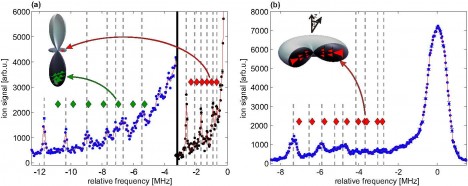 A collaboration between the theory group ‘Fundamental processes in quantum physics’ at the centre for optical quantum technologies led by Prof. Peter Schmelcher (CUI) and the experimental group of Tilmann Pfau at the University of Stuttgart has very recently demonstrated the formation of ultralong-range Rydberg D-state molecules via photoassociation in an ultracold cloud of rubidium atoms.
A collaboration between the theory group ‘Fundamental processes in quantum physics’ at the centre for optical quantum technologies led by Prof. Peter Schmelcher (CUI) and the experimental group of Tilmann Pfau at the University of Stuttgart has very recently demonstrated the formation of ultralong-range Rydberg D-state molecules via photoassociation in an ultracold cloud of rubidium atoms.
By applying a magnetic offset field on the order of a few Gauss and high resolution spectroscopy, they succeeded in resolving individual rovibrational molecular states. A full theory based on the Born-Oppenheimer approximation including s- and p-wave scattering already reproduces well the measured binding energies. The calculated molecular wavefunctions show that in the experiment it is possible to selectively excite stationary molecular states with an extraordinary degree of alignment or anti-alignment with respect to the magnetic field axis.
This work opens the doorway to an extensive weak field control of ultralong-range Rydberg molecules including the change of molecular geometries of diatomics and polyatomics by applying external static electric and magnetic fields.
Citation:
Krupp et al., Phys. Rev. Lett. 112, 143008 (2014)
DOI: 10.1103/

